
Sandra Segura-Bayona
@ssegurabayona.bsky.social
Postdoctoral researcher in the Boulton Lab 🧬 The Francis Crick Institute, London, UK▪️interest in genome stability, chromatin, cancer 🧫 👩🔬 EMBO and MSCA fellow
Reposted by Sandra Segura-Bayona
Our paper in Science is out! @souravagrawal.bsky.social, @rlynn.bsky.social, @susvirkar.bsky.social, and the rest of the team show human RPA is a telomerase processivity factor essential for telomere maintenance. This reshapes our thinking about telomerase regulation. www.science.org/doi/10.1126/...

Human RPA is an essential telomerase processivity factor for maintaining telomeres
Telomerase counteracts telomere shortening by repeatedly adding DNA repeats to chromosome ends. We identified the replication protein A (RPA) heterotrimer as a telomerase processivity factor critical ...
www.science.org
October 30, 2025 at 10:07 PM
Our paper in Science is out! @souravagrawal.bsky.social, @rlynn.bsky.social, @susvirkar.bsky.social, and the rest of the team show human RPA is a telomerase processivity factor essential for telomere maintenance. This reshapes our thinking about telomerase regulation. www.science.org/doi/10.1126/...
Reposted by Sandra Segura-Bayona
Want to know how homologous recombination defects are caused upon loss of BRCA2? Check out our recent efforts in uncovering this phenomenon just out in Science!
www.science.org/doi/10.1126/...
www.science.org/doi/10.1126/...

FIGNL1 inhibits homologous recombination in BRCA2 deficient cells by dissociating RAD51 filaments
Homologous recombination (HR) deficiency upon Breast Cancer Gene 2 (BRCA2) loss arises from defects in the formation of RAD51 nucleoprotein filaments. We demonstrate that loss of the anti-recombinase ...
www.science.org
October 30, 2025 at 9:52 PM
Want to know how homologous recombination defects are caused upon loss of BRCA2? Check out our recent efforts in uncovering this phenomenon just out in Science!
www.science.org/doi/10.1126/...
www.science.org/doi/10.1126/...
Reposted by Sandra Segura-Bayona
What do the naked mole rat and bowhead whale (lives to ~200 years) have in common to explain their remarkable longevity?
Enhanced DNA repair
www.nature.com/articles/s41...
erictopol.substack.com/p/a-long-awa...
Enhanced DNA repair
www.nature.com/articles/s41...
erictopol.substack.com/p/a-long-awa...

Evidence for improved DNA repair in long-lived bowhead whale - Nature
Analysis of the longest-lived mammal, the bowhead whale, reveals an improved ability to repair DNA breaks, mediated by high levels of cold-inducible RNA-binding protein. &nbs...
www.nature.com
October 29, 2025 at 4:26 PM
What do the naked mole rat and bowhead whale (lives to ~200 years) have in common to explain their remarkable longevity?
Enhanced DNA repair
www.nature.com/articles/s41...
erictopol.substack.com/p/a-long-awa...
Enhanced DNA repair
www.nature.com/articles/s41...
erictopol.substack.com/p/a-long-awa...
Fantastic day of genome dynamics workshop at @cabimer.bsky.social, stimulating discussions and exciting science from across Spain and beyond in beautiful Sevilla! Thanks to all organisers for a great event 🧬
We are very happy with the GenomaHub @csic.es Workshop on "Genome dynamics from development to disease" held at our institute was a great success. Organized by @nestorgarciarod.bsky.social , @romangp.bsky.social , Cristina Gonzalez-Aguilera and Belén Gómez-González. Thanks to all the participants!




October 18, 2025 at 3:00 PM
Fantastic day of genome dynamics workshop at @cabimer.bsky.social, stimulating discussions and exciting science from across Spain and beyond in beautiful Sevilla! Thanks to all organisers for a great event 🧬
🧬 Preprint alert!
"Distinct ATRX functions cooperate with 9-1-1 and CST complexes to safeguard replication and telomere integrity."
Read the manuscript here 👉 www.biorxiv.org/content/10.1...
"Distinct ATRX functions cooperate with 9-1-1 and CST complexes to safeguard replication and telomere integrity."
Read the manuscript here 👉 www.biorxiv.org/content/10.1...

Distinct ATRX functions cooperate with 9-1-1 and CST complexes to safeguard replication and telomere integrity
Mutations in the ATRX chromatin remodeller predispose to a developmental genetic disorder and cancer, but how it safeguards genome and telomere stability remains unresolved. Here, we uncover critical ...
www.biorxiv.org
October 7, 2025 at 9:49 PM
🧬 Preprint alert!
"Distinct ATRX functions cooperate with 9-1-1 and CST complexes to safeguard replication and telomere integrity."
Read the manuscript here 👉 www.biorxiv.org/content/10.1...
"Distinct ATRX functions cooperate with 9-1-1 and CST complexes to safeguard replication and telomere integrity."
Read the manuscript here 👉 www.biorxiv.org/content/10.1...
Reposted by Sandra Segura-Bayona
Are you interested in working on related projects? 🌱
The Knipscheer lab at the Hubrecht Institute (Utrecht, the Netherlands) has openings for a postdoc and a PhD position.
Apply here: www.hubrecht.eu/jobs
The Knipscheer lab at the Hubrecht Institute (Utrecht, the Netherlands) has openings for a postdoc and a PhD position.
Apply here: www.hubrecht.eu/jobs
September 19, 2025 at 12:32 PM
Are you interested in working on related projects? 🌱
The Knipscheer lab at the Hubrecht Institute (Utrecht, the Netherlands) has openings for a postdoc and a PhD position.
Apply here: www.hubrecht.eu/jobs
The Knipscheer lab at the Hubrecht Institute (Utrecht, the Netherlands) has openings for a postdoc and a PhD position.
Apply here: www.hubrecht.eu/jobs
🚀 New preprint alert!
We uncover SLFN11 as a molecular gatekeeper that restricts alternative lengthening of telomeres (ALT) by sensing telomere-associated replication stress and triggering apoptosis.
📄 Read the manuscript here: www.biorxiv.org/content/10.1...
We uncover SLFN11 as a molecular gatekeeper that restricts alternative lengthening of telomeres (ALT) by sensing telomere-associated replication stress and triggering apoptosis.
📄 Read the manuscript here: www.biorxiv.org/content/10.1...

SLFN11 restricts escape from telomere crisis to prevent alternative lengthening of telomeres
The tRNA nuclease SLFN11 is epigenetically silenced in ~50% of treatment-naive tumours and is the strongest predictor of chemoresistance but why it is frequently inactivated in cancer is unknown. To a...
www.biorxiv.org
September 11, 2025 at 7:23 AM
🚀 New preprint alert!
We uncover SLFN11 as a molecular gatekeeper that restricts alternative lengthening of telomeres (ALT) by sensing telomere-associated replication stress and triggering apoptosis.
📄 Read the manuscript here: www.biorxiv.org/content/10.1...
We uncover SLFN11 as a molecular gatekeeper that restricts alternative lengthening of telomeres (ALT) by sensing telomere-associated replication stress and triggering apoptosis.
📄 Read the manuscript here: www.biorxiv.org/content/10.1...
Reposted by Sandra Segura-Bayona
Cytarabine has been the mainstay for AML treatment for over 50 years. This chemotherapy can lead to problems with movement and balance. Here we explain this neurotoxic side-effect. www.nature.com/articles/s41... Work led by Jia-Cheng Liu, Donpeng Wang and Elsa Callen and terrific collaborators!

Mechanism of cytarabine-induced neurotoxicity - Nature
Certain antimetabolites used to treat cancer are more neurotoxic than others, and it is now shown that this is due to their greater tendency to generate DNA double-stranded breaks, whereas less n...
www.nature.com
June 25, 2025 at 3:59 PM
Cytarabine has been the mainstay for AML treatment for over 50 years. This chemotherapy can lead to problems with movement and balance. Here we explain this neurotoxic side-effect. www.nature.com/articles/s41... Work led by Jia-Cheng Liu, Donpeng Wang and Elsa Callen and terrific collaborators!
Reposted by Sandra Segura-Bayona
Excited our paper is out! G-quadruplex (G4) unwinding via an intricate G-loop assembly and disassembly mechanism maintains genome integrity. Pioneered by Koichi Sato with great collaborators Jing Lyu and @simonelsasser.bsky.social Check it out: www.science.org/doi/10.1126/science.adr0493 🧵(1/4)
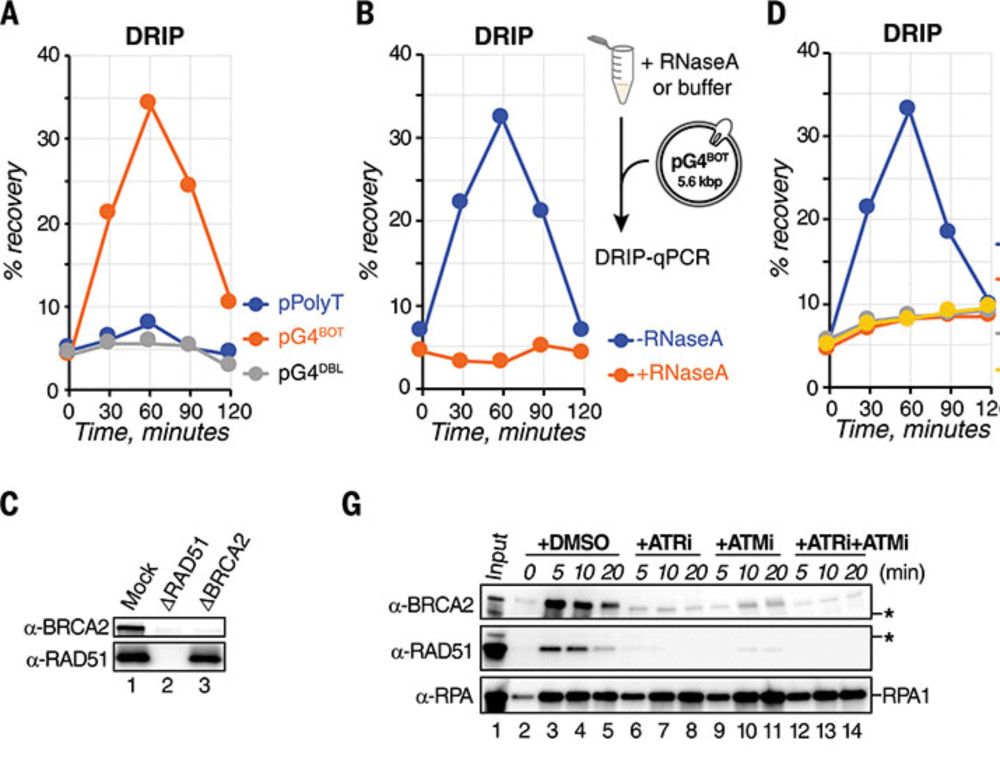
RNA transcripts regulate G-quadruplex landscapes through G-loop formation
G-quadruplexes (G4s) are prevalent DNA structures that regulate transcription but also threaten genome stability. How G4 dynamics are controlled remains poorly understood. Here, we report that RNA tra...
www.science.org
June 13, 2025 at 9:33 AM
Excited our paper is out! G-quadruplex (G4) unwinding via an intricate G-loop assembly and disassembly mechanism maintains genome integrity. Pioneered by Koichi Sato with great collaborators Jing Lyu and @simonelsasser.bsky.social Check it out: www.science.org/doi/10.1126/science.adr0493 🧵(1/4)
Reposted by Sandra Segura-Bayona
Save de date! Join us at @cabimer.bsky.social on October 17th for the @GenomaHubCSIC Workshop in "Genome Dynamics in Development and Disease". Slots available for talks! Registration opens soon!!
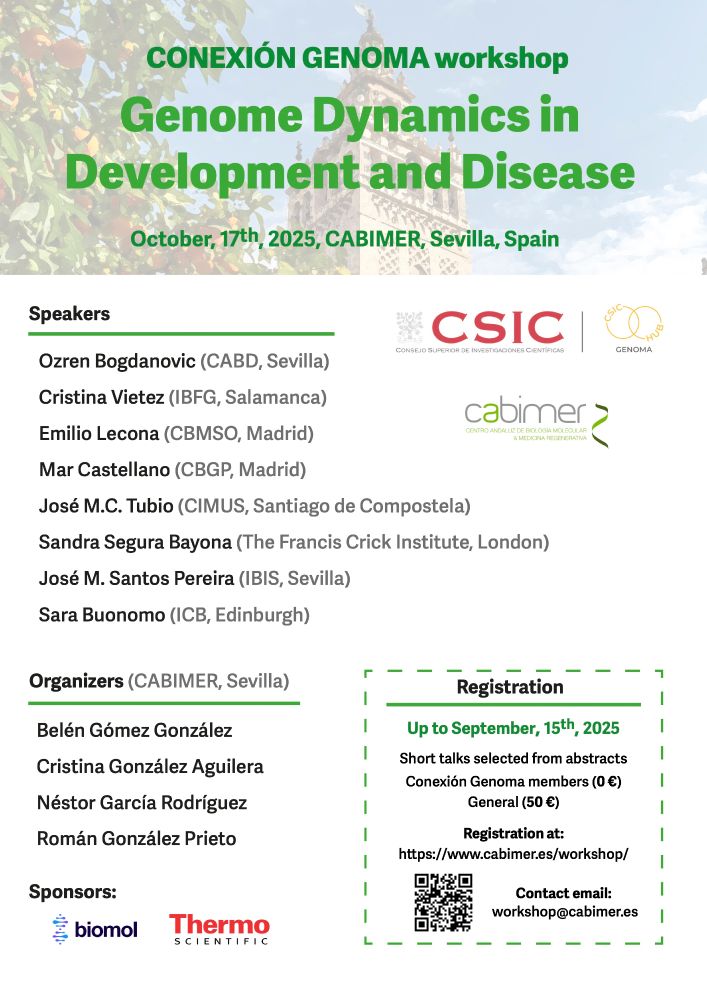
May 30, 2025 at 12:44 PM
Save de date! Join us at @cabimer.bsky.social on October 17th for the @GenomaHubCSIC Workshop in "Genome Dynamics in Development and Disease". Slots available for talks! Registration opens soon!!
Reposted by Sandra Segura-Bayona
Are you ready for the 2nd half of 2025? Social DNAing is ready. Check out the speaker list and schedule! Sign up at www.cancer.columbia.edu/research/pro...
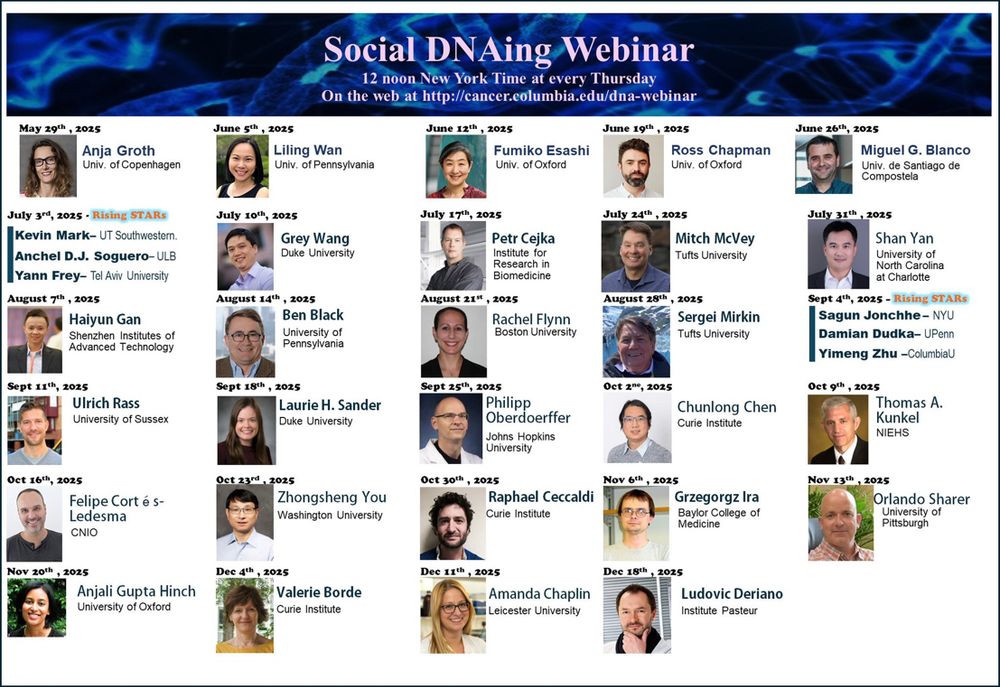
May 20, 2025 at 2:58 AM
Are you ready for the 2nd half of 2025? Social DNAing is ready. Check out the speaker list and schedule! Sign up at www.cancer.columbia.edu/research/pro...
Reposted by Sandra Segura-Bayona
Delighted to share that the results of my main postdoc project are now published in @nature.com
🔗 doi.org/10.1038/s415...
🔗 doi.org/10.1038/s415...

Multigenerational cell tracking of DNA replication and heritable DNA damage - Nature
A multigenerational single-cell tracking approach provides a framework to dissect phenotypic plasticity at the single-cell level, offering insights into cellular processes that may resemble early even...
doi.org
May 21, 2025 at 3:27 PM
Delighted to share that the results of my main postdoc project are now published in @nature.com
🔗 doi.org/10.1038/s415...
🔗 doi.org/10.1038/s415...
Reposted by Sandra Segura-Bayona
Excited to share our new paper on Nature - how Ku accommodates Alu expansion in primates by binding to dsRNA, providing a clue for both the high levels of Ku and its essentiality in human cells. Thank @chaolinzhang @hchung03 @LenaSteckelberg More to come www.nature.com/articles/s41...
Ku limits RNA-induced innate immunity to allow Alu-expansion in primates - Nature
Nature - Ku limits RNA-induced innate immunity to allow Alu-expansion in primates
www.nature.com
May 16, 2025 at 11:11 PM
Excited to share our new paper on Nature - how Ku accommodates Alu expansion in primates by binding to dsRNA, providing a clue for both the high levels of Ku and its essentiality in human cells. Thank @chaolinzhang @hchung03 @LenaSteckelberg More to come www.nature.com/articles/s41...
Reposted by Sandra Segura-Bayona
### PhD position alert ###
Please repost!
I'm excited to announce a new *PhD position* within our group.
We are looking for a super-motivated candidate with a solid basis in wet- and dry-lab research. Apply now & make sure to include all docs!
werkenbijprinsesmaximacentrum.nl/en/vacancy/p...
Please repost!
I'm excited to announce a new *PhD position* within our group.
We are looking for a super-motivated candidate with a solid basis in wet- and dry-lab research. Apply now & make sure to include all docs!
werkenbijprinsesmaximacentrum.nl/en/vacancy/p...
PhD Position: Unraveling the Dark Proteome in Pediatric Cancer - Werken bij Prinses Maxima Centrum
Background For decades, vast stretches of the genome were dismissed as non-functional ‘junk’. However, our group and others have revealed that these regions harbor numerous non-canonical open reading ...
werkenbijprinsesmaximacentrum.nl
May 16, 2025 at 9:04 AM
### PhD position alert ###
Please repost!
I'm excited to announce a new *PhD position* within our group.
We are looking for a super-motivated candidate with a solid basis in wet- and dry-lab research. Apply now & make sure to include all docs!
werkenbijprinsesmaximacentrum.nl/en/vacancy/p...
Please repost!
I'm excited to announce a new *PhD position* within our group.
We are looking for a super-motivated candidate with a solid basis in wet- and dry-lab research. Apply now & make sure to include all docs!
werkenbijprinsesmaximacentrum.nl/en/vacancy/p...
Reposted by Sandra Segura-Bayona
Excited to share our latest from my postdoc at @mskcancercenter.bsky.social in the Sfeir Lab, in collaboration with the Simon Powell Lab! We uncovered a novel genome repair mechanism in human cells: RNA-templated DNA double-strand break repair (RT-DSBR). (1/5)
May 12, 2025 at 5:49 PM
Excited to share our latest from my postdoc at @mskcancercenter.bsky.social in the Sfeir Lab, in collaboration with the Simon Powell Lab! We uncovered a novel genome repair mechanism in human cells: RNA-templated DNA double-strand break repair (RT-DSBR). (1/5)
Reposted by Sandra Segura-Bayona
Exciting seminar series from Genome integrity italian Network (GiiN), chaired by myself and Raffaella Di Micco! Short talks (2x30’), at convenient time for EU/USA attendees. Big shots and raising stars in an expanding field. See flyers + link to receive email alerts. Please repost to your network!👇

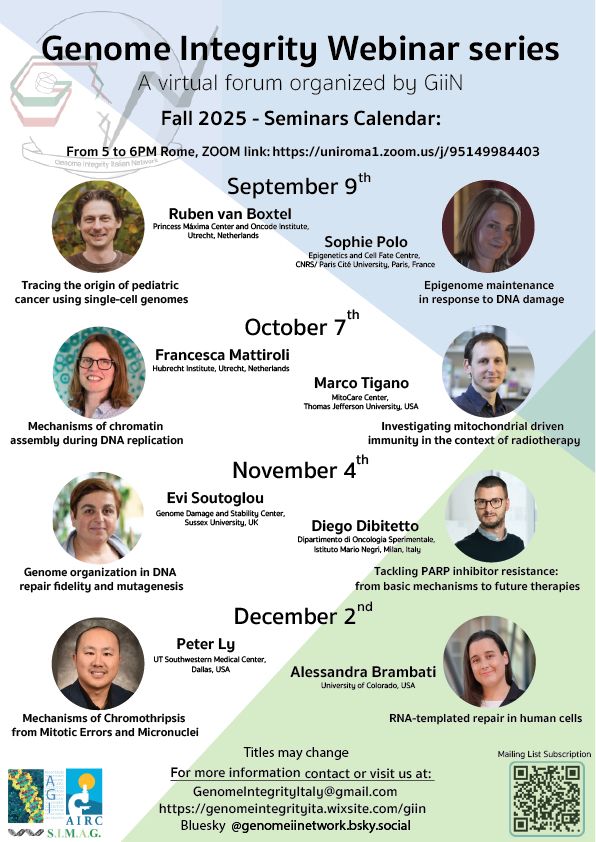
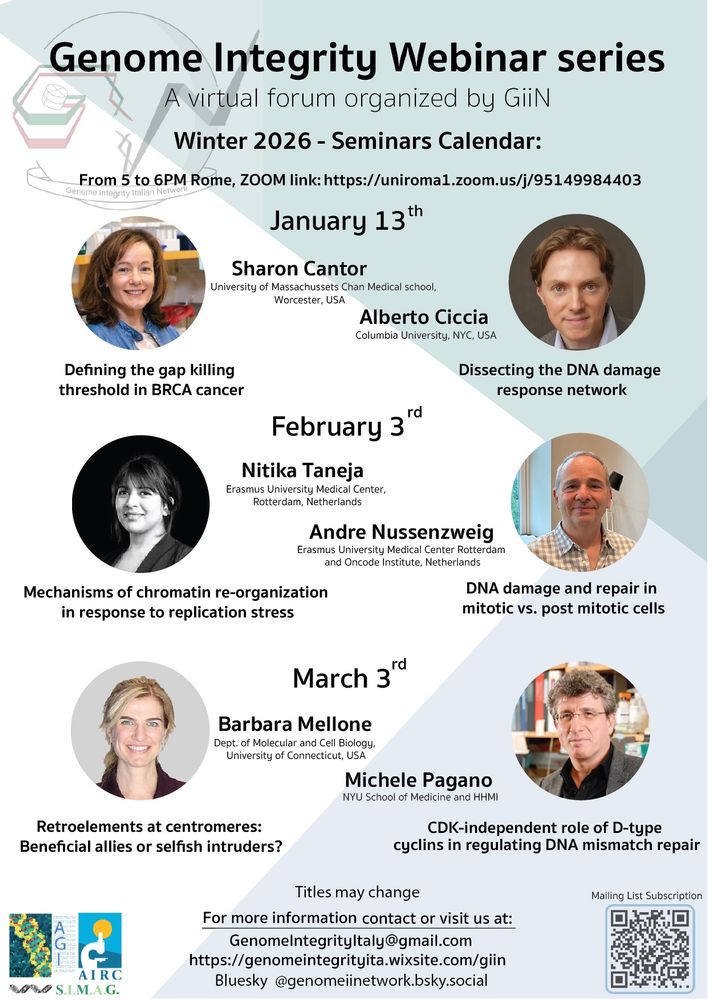
March 17, 2025 at 9:58 PM
Exciting seminar series from Genome integrity italian Network (GiiN), chaired by myself and Raffaella Di Micco! Short talks (2x30’), at convenient time for EU/USA attendees. Big shots and raising stars in an expanding field. See flyers + link to receive email alerts. Please repost to your network!👇
Reposted by Sandra Segura-Bayona
How do replisomes walk on DNA? And what happens when they run into a G-quadruplex? @sahilbatra.bsky.social and @benallwein.bsky.social provide unexpected insight in our latest paper with Richard Hite @mskcancercenter.bsky.social @science.org www.science.org/doi/10.1126/.... Congrats to all authors!
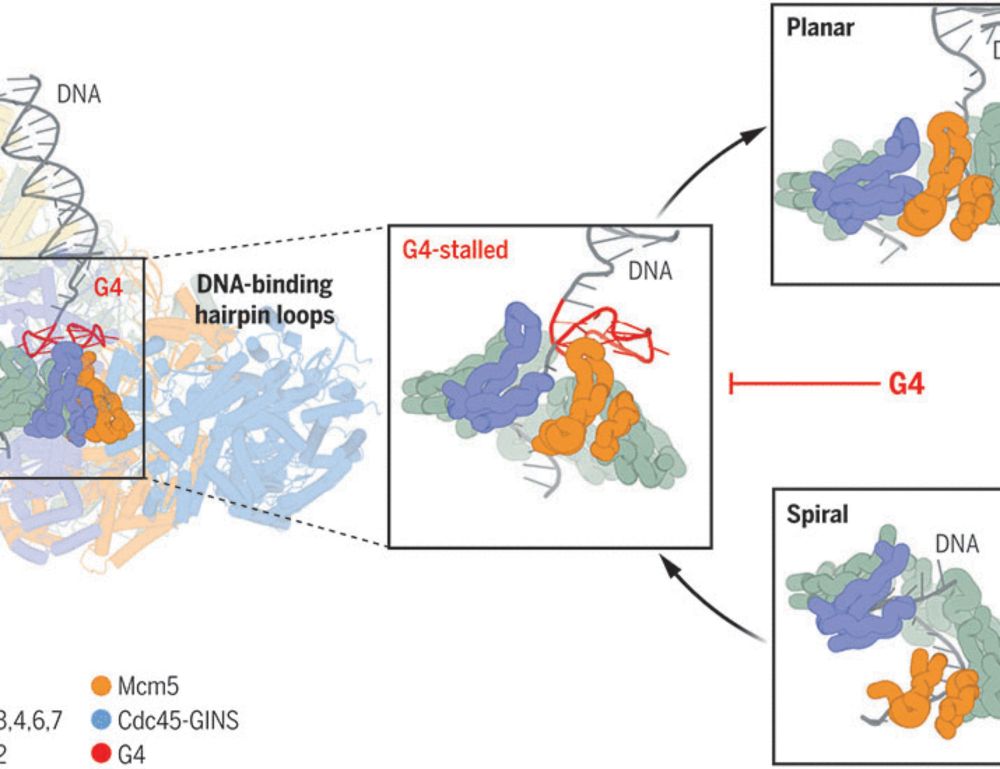
G-quadruplex–stalled eukaryotic replisome structure reveals helical inchworm DNA translocation
DNA G-quadruplexes (G4s) are non–B-form DNA secondary structures that threaten genome stability by impeding DNA replication. To elucidate how G4s induce replication fork arrest, we characterized fork ...
www.science.org
March 6, 2025 at 9:30 PM
How do replisomes walk on DNA? And what happens when they run into a G-quadruplex? @sahilbatra.bsky.social and @benallwein.bsky.social provide unexpected insight in our latest paper with Richard Hite @mskcancercenter.bsky.social @science.org www.science.org/doi/10.1126/.... Congrats to all authors!
Reposted by Sandra Segura-Bayona
𝐇𝐨𝐰 𝐝𝐨 𝐜𝐞𝐥𝐥𝐬 𝐫𝐞𝐦𝐞𝐦𝐛𝐞𝐫 𝐰𝐡𝐨 𝐭𝐡𝐞𝐲 𝐚𝐫𝐞 𝐚𝐟𝐭𝐞𝐫 𝐃𝐍𝐀 𝐫𝐞𝐩𝐥𝐢𝐜𝐚𝐭𝐢𝐨𝐧? Our new study “Disabling leading and lagging strand histone transmission results in parental histones loss and reduced cell plasticity and viability” is out in 𝘚𝘤𝘪𝘦𝘯𝘤𝘦 𝘈𝘥𝘷𝘢𝘯𝘤𝘦𝘴. Led by @lleonie.bsky.social @biranalva.bsky.social 🧵 More below👇
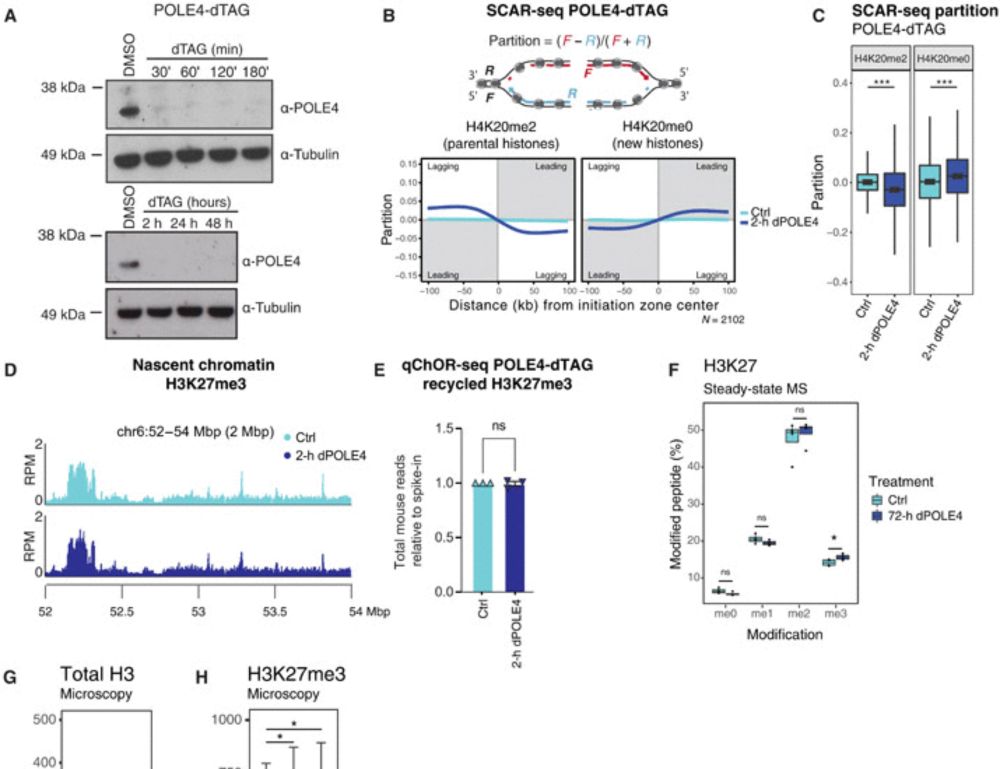
Disabling leading and lagging strand histone transmission results in parental histones loss and reduced cell plasticity and viability
Losing parental histones during DNA replication fork passage challenges differentiation competence and cell viability.
tinyurl.com
February 19, 2025 at 7:35 PM
𝐇𝐨𝐰 𝐝𝐨 𝐜𝐞𝐥𝐥𝐬 𝐫𝐞𝐦𝐞𝐦𝐛𝐞𝐫 𝐰𝐡𝐨 𝐭𝐡𝐞𝐲 𝐚𝐫𝐞 𝐚𝐟𝐭𝐞𝐫 𝐃𝐍𝐀 𝐫𝐞𝐩𝐥𝐢𝐜𝐚𝐭𝐢𝐨𝐧? Our new study “Disabling leading and lagging strand histone transmission results in parental histones loss and reduced cell plasticity and viability” is out in 𝘚𝘤𝘪𝘦𝘯𝘤𝘦 𝘈𝘥𝘷𝘢𝘯𝘤𝘦𝘴. Led by @lleonie.bsky.social @biranalva.bsky.social 🧵 More below👇
Reposted by Sandra Segura-Bayona
Cells are filled with toxic stuff that damages healthy proteins. Is that garbage just left to rot on the curb? No way! Ubiquitin ligases have evolved to recognize chemical damage and clean it up! www.nature.com/articles/s41...

C-terminal amides mark proteins for degradation via SCF–FBXO31 - Nature
SCF–FBXO31 scans proteins for C-terminal amidation and marks them for subsequent proteasomal degradation.
www.nature.com
January 30, 2025 at 12:30 PM
Cells are filled with toxic stuff that damages healthy proteins. Is that garbage just left to rot on the curb? No way! Ubiquitin ligases have evolved to recognize chemical damage and clean it up! www.nature.com/articles/s41...
Reposted by Sandra Segura-Bayona
1/Delighted to announce the newest paper from our lab, “Homologous recombination promotes non-immunogenic mitotic cell death upon DNA damage”, is out today in @naturecellbiology.bsky.social, www.nature.com/articles/s41....

Homologous recombination promotes non-immunogenic mitotic cell death upon DNA damage - Nature Cell Biology
Szmyd et al. show that DNA repair pathways impact whether cells with DNA lesions arrest in mitosis. The formation of homologous recombination-driven double Holliday junctions elicits mitotic cell deat...
www.nature.com
January 13, 2025 at 10:12 AM
1/Delighted to announce the newest paper from our lab, “Homologous recombination promotes non-immunogenic mitotic cell death upon DNA damage”, is out today in @naturecellbiology.bsky.social, www.nature.com/articles/s41....
Reposted by Sandra Segura-Bayona
Merry Boulton Lab Retreat! Great fun team building and going over some hot topics in DDR/chromatin/immune biology. Same again next year please! @mattdnewton.bsky.social @ssegurabayona.bsky.social @federicaraguseo.bsky.social @claralnovo.bsky.social


December 15, 2024 at 8:21 AM
Merry Boulton Lab Retreat! Great fun team building and going over some hot topics in DDR/chromatin/immune biology. Same again next year please! @mattdnewton.bsky.social @ssegurabayona.bsky.social @federicaraguseo.bsky.social @claralnovo.bsky.social
Reposted by Sandra Segura-Bayona
⚡️Now online⚡️: Our review on how ZAKa and #ribosomes regulate cell death when things go bad ☠️ 🧪 @cellpress.bsky.social @annaconstancevind.bsky.social 👏 ⬇️
✨ Our latest review is now online! ✨
Read about #ZAKa and #ribosomes roles in cell death triggered by:
1️⃣ Environmental and endogenous stressors
2️⃣ Plant and microbial toxins
3️⃣ Celluar pathways leading to self-inflicted ribotoxicity
@bekkerjensenlab.bsky.social 🙏
👇
www.cell.com/trends/cell-...
Read about #ZAKa and #ribosomes roles in cell death triggered by:
1️⃣ Environmental and endogenous stressors
2️⃣ Plant and microbial toxins
3️⃣ Celluar pathways leading to self-inflicted ribotoxicity
@bekkerjensenlab.bsky.social 🙏
👇
www.cell.com/trends/cell-...

Death by ribosome
Next to their essential role as protein production factories, ribosomes serve as molecular sensors of cell stress. Stalled and collided ribosomes trigger specific stress signaling, including the ribotoxic stress response (RSR). The RSR is initiated by the mitogen-activated protein (MAP)-3 kinase ZAKα in response to a plethora of translational aberrations, leading to activation of the stress-activated MAP kinases p38 and jun N-terminal kinase (JNK). Recent insights have highlighted an important role for the RSR pathway in triggering programmed cell death processes, including apoptosis and pyroptosis, in a broad range of physiologically relevant conditions. In this review, we summarize recent work on known links between programmed and accidental ribosome toxicity, RSR signaling, and cell death.
www.cell.com
December 12, 2024 at 10:35 AM
⚡️Now online⚡️: Our review on how ZAKa and #ribosomes regulate cell death when things go bad ☠️ 🧪 @cellpress.bsky.social @annaconstancevind.bsky.social 👏 ⬇️
Reposted by Sandra Segura-Bayona
The first paper from our lab is online! A wonderful collaboration with @scottbscience.bsky.social lab. We discover that Pol II is extensively regulated by Ubiquitin at the beginning of the transcription cycle!
www.cell.com/molecular-ce...
www.cell.com/molecular-ce...

CRL3ARMC5 ubiquitin ligase and Integrator phosphatase form parallel mechanisms to control early stages of RNA Pol II transcription
Cacioppo, Gillis, Shlamovitz, Zeller, et al. show that CRL3ARMC5 ubiquitylates RNA Pol II at early stages of transcription as part of a major homeostatic RNA Pol II turnover mechanism. CRL3ARMC5 and the Integrator phosphatase act as complementary pathways, monitoring the quantity and quality of RNA Pol II complexes before they are licensed into elongation.
www.cell.com
December 11, 2024 at 5:19 PM
The first paper from our lab is online! A wonderful collaboration with @scottbscience.bsky.social lab. We discover that Pol II is extensively regulated by Ubiquitin at the beginning of the transcription cycle!
www.cell.com/molecular-ce...
www.cell.com/molecular-ce...
Reposted by Sandra Segura-Bayona
Our work on how CPEB4 mis-splicing leads to its aggregation in autism spectrum disorder is now published in Nature.
rdcu.be/d2qjW
I would like to thank the collaborators who joined the team during the revision process as well as the funders who supported us.
rdcu.be/d2qjW
I would like to thank the collaborators who joined the team during the revision process as well as the funders who supported us.
December 4, 2024 at 10:13 PM
Our work on how CPEB4 mis-splicing leads to its aggregation in autism spectrum disorder is now published in Nature.
rdcu.be/d2qjW
I would like to thank the collaborators who joined the team during the revision process as well as the funders who supported us.
rdcu.be/d2qjW
I would like to thank the collaborators who joined the team during the revision process as well as the funders who supported us.
Reposted by Sandra Segura-Bayona
What are your plans for October 2025? It would be a fantastic time to visit Norway for the Endogenous DNA Damage and Repair conference with a stellar set of speaker covering a wide range of topics. www.endodnadamage.com
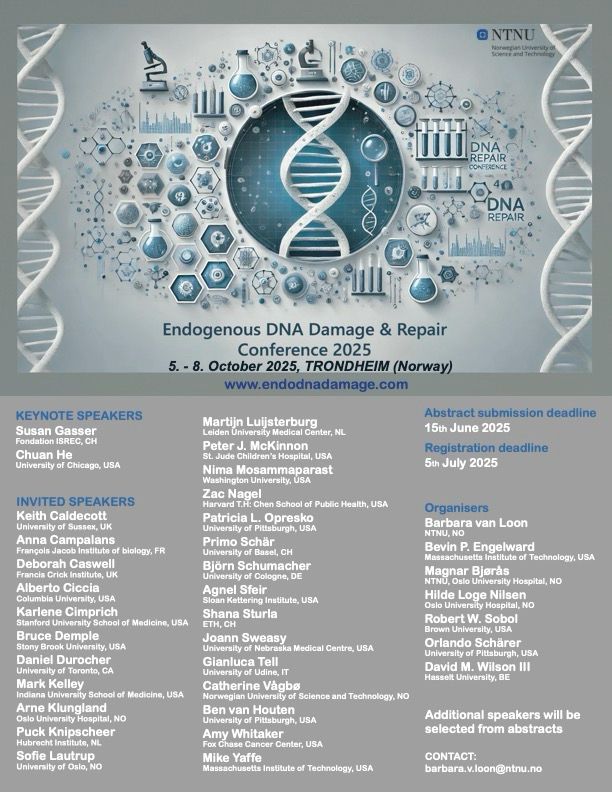
December 4, 2024 at 11:14 AM
What are your plans for October 2025? It would be a fantastic time to visit Norway for the Endogenous DNA Damage and Repair conference with a stellar set of speaker covering a wide range of topics. www.endodnadamage.com

